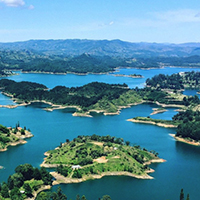The first floristic study of freshwater dinoflagellates (Dinophyceae) in Colombia

Submitted: 16 April 2021
Accepted: 23 July 2021
Published: 7 October 2021
Accepted: 23 July 2021
Abstract Views: 1908
PDF: 431
HTML: 554
HTML: 554
Publisher's note
All claims expressed in this article are solely those of the authors and do not necessarily represent those of their affiliated organizations, or those of the publisher, the editors and the reviewers. Any product that may be evaluated in this article or claim that may be made by its manufacturer is not guaranteed or endorsed by the publisher.
All claims expressed in this article are solely those of the authors and do not necessarily represent those of their affiliated organizations, or those of the publisher, the editors and the reviewers. Any product that may be evaluated in this article or claim that may be made by its manufacturer is not guaranteed or endorsed by the publisher.
Similar Articles
- Baoli WANG, Cong-Qiang LIU, Fushun WANG, Yuanxiu YU, Yanyou WU, Flow cytometric observation of picophytoplankton community structure in the cascade reservoirs along the Wujiang River, SW China , Journal of Limnology: Vol. 68 No. 1 (2009)
- Robert STURM, Freshwater molluscs in mountain lakes of the Eastern Alps (Austria): relationship between environmental variables and lake colonization , Journal of Limnology: Vol. 66 No. 2 (2007)
- Jarl Eivind LØVIK, Gösta KJELLBERG, Long-term changes of the crustacean zooplankton community in Lake Mjøsa, the largest lake in Norway , Journal of Limnology: Vol. 62 No. 2 (2003)
- Marco SIMONA, Alberto BARBIERI, Mauro VERONESI, Stefano MALUSARDI, Viera STRAŠKRABOVÁ, Seasonal dynamics of plankton in a mountain lake in the southern Alps (Laghetto Inferiore, Switzerland) , Journal of Limnology: Vol. 58 No. 2 (1999)
- Marco Pilotti, Stefano Simoncelli, Giulia Valerio, Computing the transport time scales of a stratified lake on the basis of Tonolli’s model , Journal of Limnology: Vol. 73 No. 3 (2014)
- Franco GIOVANARDI, Richard A. VOLLENWEIDER, Trophic conditions of marine coastal waters: experience in applying the Trophic Index TRIX to two areas of the Adriatic and Tyrrhenian seas , Journal of Limnology: Vol. 63 No. 2 (2004)
- Barbara LEONI, Letizia GARIBALDI, Population dynamics of Chaoborus flavicans and Daphnia spp.: effects on a zooplankton community in a volcanic eutrophic lake with naturally high metal concentrations (L. Monticchio Grande, Southern Italy) , Journal of Limnology: Vol. 68 No. 1 (2009)
- Silvia Zaupa, Angela Boggero, Lyudmila Kamburska, Littoral chironomids and oligochaetes in the subalpine Lake Maggiore: a first dataset , Journal of Limnology: Vol. 81 No. s2 (2022): Effects of water level management on lake littorals and downstream river areas
- Marco CANTONATI, Horst LANGE-BERTALOT, Diatom monitors of close-to-pristine, very-low alkalinity habitats: three new Eunotia species from springs in Nature Parks of the south-eastern Alps , Journal of Limnology: Vol. 70 No. 2 (2011)
- Elisa BURASCHI, Franco SALERNO, Chiara MONGUZZI, Giulia BARBIERO, Gianni TARTARI, Characterization of the Italian lake-types and identification of their reference sites using anthropogenic pressure factors , Journal of Limnology: Vol. 64 No. 1 (2005)
<< < 53 54 55 56 57 58 59 60 61 62 > >>
You may also start an advanced similarity search for this article.

 https://doi.org/10.4081/jlimnol.2021.2023
https://doi.org/10.4081/jlimnol.2021.2023






